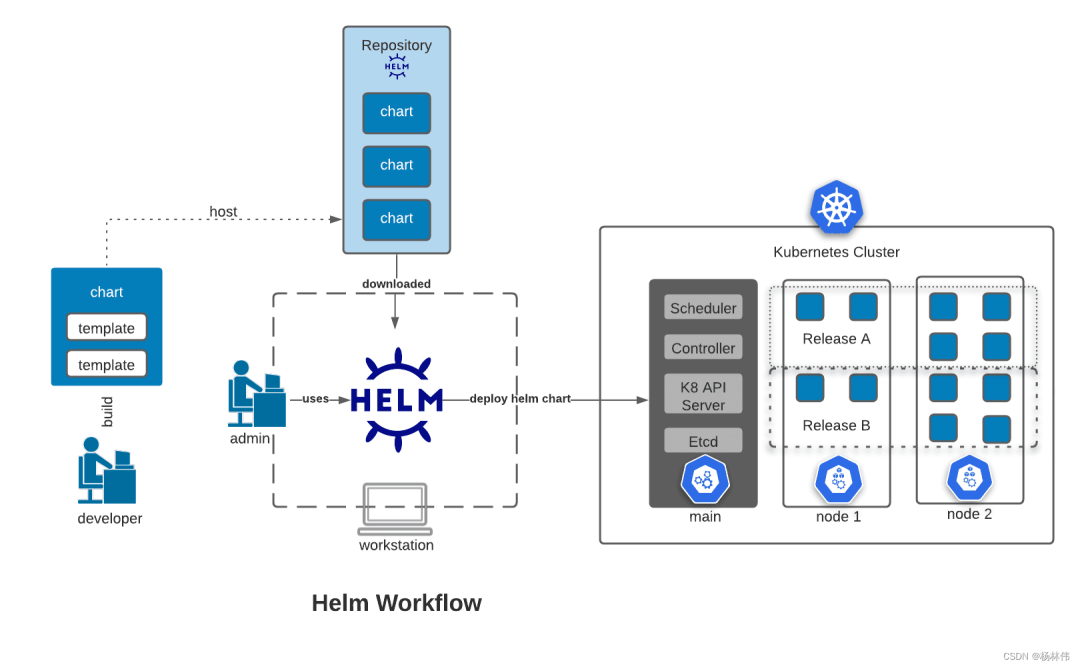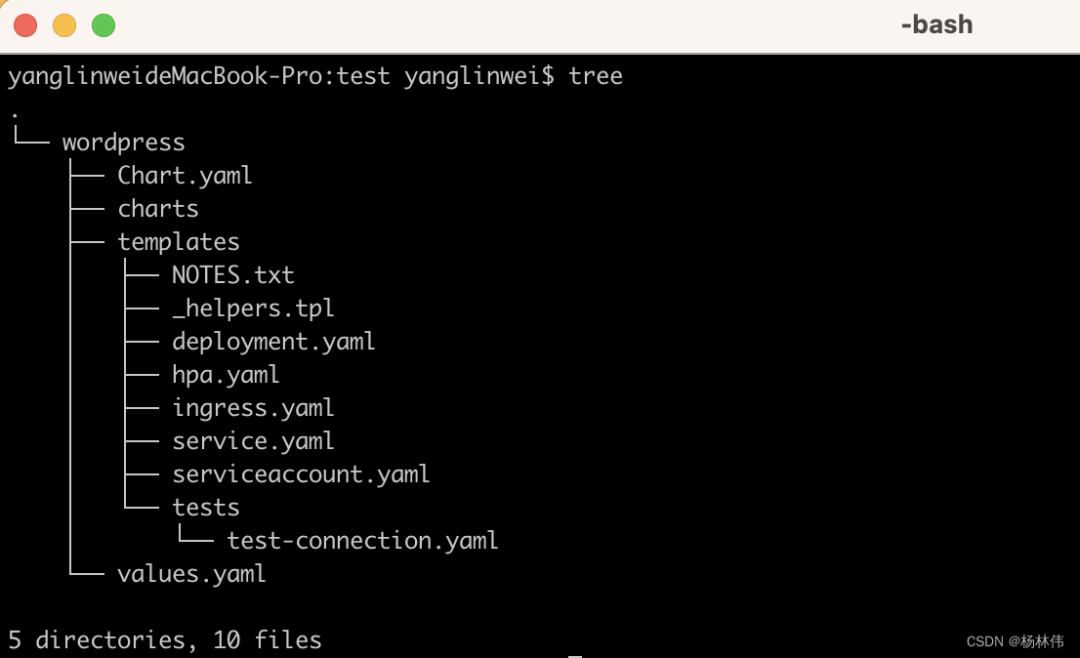

Helm的一些概念及用法
描述
一、前言
在 k8s 中,我们很多时候需要部署很多个应用,特别是微服务的项目,如果每个服务部署都需要使用kubectl apply依次执行,这将是一件很痛苦的事。
这个时候,如果一键部署所有应用,使用 Helm (https://helm.sh)是一个很不错的选择,它具备如下的能力:
简化部署 :Helm允许使用单个命令轻松部署和管理应用程序,从而简化了整个部署过程;
高度可配置:Helm Charts提供了高度可配置的选项,可以轻松自定义和修改应用程序的部署配置;
版本控制 :Helm允许管理应用程序的多个版本,从而轻松实现版本控制和回滚;
模板化:Helm Charts使用YAML模板来定义Kubernetes对象的配置,从而简化了配置过程,并提高了可重复性和可扩展性;
应用程序库:Helm具有应用程序库的概念,可以轻松地共享和重用Helm Charts,从而简化了多个应用程序的部署和管理;
插件系统:Helm拥有一个强大的插件系统,允许您扩展和定制Helm的功能,以满足特定的需求和要求。
Helm本质就是一个k8s的包管理器。
二、Helm工作流程
以下是Helm的工作流程(注意:这里使用的是Helm的v3版本,该版本没有了tiller而是用更加简单和灵活的架构,直接通过kubeconfig连接apiserver,简化安全模块,降低了用户的使用壁垒):

如上图所示,Helm的工作流程总结如下:
开发者首先创建并编辑chart的配置;
接着打包并发布至Helm的仓库(Repository);
当管理员使用helm命令安装时,相关的依赖会从仓库下载;
接着helm会根据下载的配置部署资源至k8s。
三、Helm概念
在使用Helm的过程中,需要理解如下的几个核心的概念:
| 概念 | 描述 |
| Chart | 一个Helm包,其中包含了运行一个应用所需要的镜像、依赖和资源定义等,还可能包含Kubernetes集群中的服务定义,类似Homebrew中的formula、APT的dpkg或者Yum的rpm文件 |
| Repository | 存储Helm Charts的地方 |
| Release | Chart在k8s上运行的Chart的一个实例,例如,如果一个MySQL Chart想在服务器上运行两个数据库,可以将这个Chart安装两次,并在每次安装中生成自己的Release以及Release名称 |
| Value | Helm Chart的参数,用于配置Kubernetes对象 |
| Template | 使用Go模板语言生成Kubernetes对象的定义文件 |
| Namespace | Kubernetes中用于隔离资源的逻辑分区 |
四、Helm的使用
下面简单讲下Helm的使用。
4.1 安装Helm
首先需要在本地机器或Kubernetes集群上安装Helm。可以从Helm官方网站下载适合自己平台的二进制文件,或使用包管理器安装Helm,安装教程参考 https://helm.sh 。
4.2 创建Chart
使用helm create命令创建一个新的Chart,Chart目录包含描述应用程序的文件和目录,包括Chart.yaml、values.yaml、templates目录等;
例如:在本地机器上使用helm create命令创建一个名为wordpress的Chart:
在当前文件夹,可以看到创建了一个wordpress的目录,且里面的内容如下:
4.3 配置Chart
使用编辑器编辑Chart配置文件,包括Chart.yaml和values.yaml。
Chart.yaml:
Chart.yaml包含Chart的元数据和依赖项
Chart.yaml的模板及注释如下:
apiVersion: chart API 版本 (必需) #必须有
name: chart名称 (必需) # 必须有
version: 语义化2 版本(必需) # 必须有
kubeVersion: 兼容Kubernetes版本的语义化版本(可选)
description: 一句话对这个项目的描述(可选)
type: chart类型 (可选)
keywords:
- 关于项目的一组关键字(可选)
home: 项目home页面的URL (可选)
sources:
- 项目源码的URL列表(可选)
dependencies: # chart 必要条件列表 (可选)
- name: chart名称 (nginx)
version: chart版本 ("1.2.3")
repository: (可选)仓库URL ("https://example.com/charts") 或别名 ("@repo-name")
condition: (可选) 解析为布尔值的yaml路径,用于启用/禁用chart (e.g. subchart1.enabled )
tags: # (可选)
- 用于一次启用/禁用 一组chart的tag
import-values: # (可选)
- ImportValue 保存源值到导入父键的映射。每项可以是字符串或者一对子/父列表项
alias: (可选) chart中使用的别名。当你要多次添加相同的chart时会很有用
maintainers: # (可选) # 可能用到
- name: 维护者名字 (每个维护者都需要)
email: 维护者邮箱 (每个维护者可选)
url: 维护者URL (每个维护者可选)
icon: 用做icon的SVG或PNG图片URL (可选)
appVersion: 包含的应用版本(可选)。不需要是语义化,建议使用引号
deprecated: 不被推荐的chart (可选,布尔值)
annotations:
example: 按名称输入的批注列表 (可选).
举例:
name: nginx-helm apiVersion: v1 version: 1.0.0
Values.yaml:
values.yaml包含应用程序的默认配置值,举例:
image: repository: nginx tag: '1.19.8'
templates:
在模板中引入values.yaml里的配置,在模板文件中可以通过 .VAlues对象访问到,例如:
apiVersion: apps/v1
kind: Deployment
metadata:
name: nginx-helm-{{ .Values.image.repository }}
spec:
replicas: 1
selector:
matchLabels:
app: nginx-helm
template:
metadata:
labels:
app: nginx-helm
spec:
containers:
- name: nginx-helm
image: {{ .Values.image.repository }}:{{ .Values.image.tag }}
ports:
- containerPort: 80
protocol: TCP
4.4 打包Chart
使用helm package命令将Chart打包为一个tarball文件,例如在wordpress目录中使用helm package命令将Chart打包为一个tarball文件,这将生成一个名为wordpress-0.1.0.tgz的tarball文件:
helm package wordpress/
4.5 发布Chart
将打包好的Chart发布到一个Helm Repository中。可以使用 helm repo add 命令添加一个Repository,然后使用helm push命令将Chart推送到Repository中,例如:
helm repo add myrepo https://example.com/charts helm push wordpress-0.1.0.tgz myrepo
4.6 安装Release
使用helm install命令安装Chart的Release,可以通过命令行选项或指定values.yaml文件来配置Release,例如:
helm install mywordpress myrepo/wordpress
这将在Kubernetes集群中创建一个名为mywordpress的Release,包含WordPress应用程序和MySQL数据库。
4.7 管理Release
使用helm ls命令查看当前运行的Release列表,例如:
helm upgrade mywordpress myrepo/wordpress --set image.tag=5.7.3-php8.0-fpm-alpine
这将升级 mywordpress 的WordPress应用程序镜像版本为5.7.3-php8.0-fpm-alpine。
可以使用helm rollback命令回滚到先前版本,例如:
helm rollback mywordpress 1
这将回滚mywordpress的版本到1。
4.8 更新Chart
在应用程序更新时,可以更新Chart配置文件和模板,并使用helm package命令重新打包Chart。然后可以使用helm upgrade命令升级已安装的Release,可以按照以下步骤更新Chart:
在本地编辑Chart配置或添加新的依赖项;
使用helm package命令打包新的Chart版本;
使用helm push命令将新的Chart版本推送到Repository中;
使用helm repo update命令更新本地或远程的Helm Repository;
使用helm upgrade命令升级现有Release到新的Chart版本。
例如,可以使用以下命令更新WordPress的Chart版本:
helm upgrade mywordpress myrepo/wordpress --version 0.2.0
这将升级mywordpress的Chart版本到0.2.0,其中包括新的配置和依赖项。
如果需要删除一个Release,可以使用helm uninstall命令。例如:
helm uninstall mywordpress
这将删除名为mywordpress的Release,同时删除WordPress应用程序和MySQL数据库。
如果需要删除与Release相关的PersistentVolumeClaim,可以使用helm uninstall命令的--delete-data选项,例如:
helm uninstall mywordpress --delete-data
这将删除名为mywordpress的Release,并删除与之相关的所有PersistentVolumeClaim。
五、Helm的执行安装顺序
Helm按照以下顺序安装资源:
Namespace
NetworkPolicy
ResourceQuota
LimitRange
PodSecurityPolicy
PodDisruptionBudget
ServiceAccount
Secret
SecretList
ConfigMap
StorageClass
PersistentVolume
PersistentVolumeClaim
CustomResourceDefinition
ClusterRole
ClusterRoleList
ClusterRoleBinding
ClusterRoleBindingList
Role
RoleList
RoleBinding
RoleBindingList
Service
DaemonSet
Pod
ReplicationController
ReplicaSet
Deployment
HorizontalPodAutoscaler
StatefulSet
Job
CronJob
Ingress
APIService
Helm 客户端不会等到所有资源都运行才退出,可以使用 helm status 来追踪 release 的状态,或是重新读取配置信息:
# $ helm status mynginx NAME: mynginx LAST DEPLOYED: Fri Oct 29 1432 2021 NAMESPACE: default STATUS: deployed REVISION: 1 TEST SUITE: None
六、Helm命令汇总
在最后,附上所有helm的命令,直接控制台使用 helm --help即可查看:
The Kubernetes package manager
Common actions for Helm:
- helm search: search for charts
- helm pull: download a chart to your local directory to view
- helm install: upload the chart to Kubernetes
- helm list: list releases of charts
Environment variables:
| Name | Description |
|------------------------------------|---------------------------------------------------------------------------------------------------|
| $HELM_CACHE_HOME | set an alternative location for storing cached files. |
| $HELM_CONFIG_HOME | set an alternative location for storing Helm configuration. |
| $HELM_DATA_HOME | set an alternative location for storing Helm data. |
| $HELM_DEBUG | indicate whether or not Helm is running in Debug mode |
| $HELM_DRIVER | set the backend storage driver. Values are: configmap, secret, memory, sql. |
| $HELM_DRIVER_SQL_CONNECTION_STRING | set the connection string the SQL storage driver should use. |
| $HELM_MAX_HISTORY | set the maximum number of helm release history. |
| $HELM_NAMESPACE | set the namespace used for the helm operations. |
| $HELM_NO_PLUGINS | disable plugins. Set HELM_NO_PLUGINS=1 to disable plugins. |
| $HELM_PLUGINS | set the path to the plugins directory |
| $HELM_REGISTRY_CONFIG | set the path to the registry config file. |
| $HELM_REPOSITORY_CACHE | set the path to the repository cache directory |
| $HELM_REPOSITORY_CONFIG | set the path to the repositories file. |
| $KUBECONFIG | set an alternative Kubernetes configuration file (default "~/.kube/config") |
| $HELM_KUBEAPISERVER | set the Kubernetes API Server Endpoint for authentication |
| $HELM_KUBECAFILE | set the Kubernetes certificate authority file. |
| $HELM_KUBEASGROUPS | set the Groups to use for impersonation using a comma-separated list. |
| $HELM_KUBEASUSER | set the Username to impersonate for the operation. |
| $HELM_KUBECONTEXT | set the name of the kubeconfig context. |
| $HELM_KUBETOKEN | set the Bearer KubeToken used for authentication. |
| $HELM_KUBEINSECURE_SKIP_TLS_VERIFY | indicate if the Kubernetes API server's certificate validation should be skipped (insecure) |
| $HELM_KUBETLS_SERVER_NAME | set the server name used to validate the Kubernetes API server certificate |
| $HELM_BURST_LIMIT | set the default burst limit in the case the server contains many CRDs (default 100, -1 to disable)|
Helm stores cache, configuration, and data based on the following configuration order:
- If a HELM_*_HOME environment variable is set, it will be used
- Otherwise, on systems supporting the XDG base directory specification, the XDG variables will be used
- When no other location is set a default location will be used based on the operating system
By default, the default directories depend on the Operating System. The defaults are listed below:
| Operating System | Cache Path | Configuration Path | Data Path |
|------------------|---------------------------|--------------------------------|-------------------------|
| Linux | $HOME/.cache/helm | $HOME/.config/helm | $HOME/.local/share/helm |
| macOS | $HOME/Library/Caches/helm | $HOME/Library/Preferences/helm | $HOME/Library/helm |
| Windows | %TEMP%helm | %APPDATA%helm | %APPDATA%helm |
Usage:
helm [command]
Available Commands:
completion generate autocompletion scripts for the specified shell
create create a new chart with the given name
dependency manage a chart's dependencies
env helm client environment information
get download extended information of a named release
help Help about any command
history fetch release history
install install a chart
lint examine a chart for possible issues
list list releases
package package a chart directory into a chart archive
plugin install, list, or uninstall Helm plugins
pull download a chart from a repository and (optionally) unpack it in local directory
push push a chart to remote
registry login to or logout from a registry
repo add, list, remove, update, and index chart repositories
rollback roll back a release to a previous revision
search search for a keyword in charts
show show information of a chart
status display the status of the named release
template locally render templates
test run tests for a release
uninstall uninstall a release
upgrade upgrade a release
verify verify that a chart at the given path has been signed and is valid
version print the client version information
Flags:
--burst-limit int client-side default throttling limit (default 100)
--debug enable verbose output
-h, --help help for helm
--kube-apiserver string the address and the port for the Kubernetes API server
--kube-as-group stringArray group to impersonate for the operation, this flag can be repeated to specify multiple groups.
--kube-as-user string username to impersonate for the operation
--kube-ca-file string the certificate authority file for the Kubernetes API server connection
--kube-context string name of the kubeconfig context to use
--kube-insecure-skip-tls-verify if true, the Kubernetes API server's certificate will not be checked for validity. This will make your HTTPS connections insecure
--kube-tls-server-name string server name to use for Kubernetes API server certificate validation. If it is not provided, the hostname used to contact the server is used
--kube-token string bearer token used for authentication
--kubeconfig string path to the kubeconfig file
-n, --namespace string namespace scope for this request
--registry-config string path to the registry config file (default "/Users/yanglinwei/Library/Preferences/helm/registry/config.json")
--repository-cache string path to the file containing cached repository indexes (default "/Users/yanglinwei/Library/Caches/helm/repository")
--repository-config string path to the file containing repository names and URLs (default "/Users/yanglinwei/Library/Preferences/helm/repositories.yaml")
Use "helm [command] --help" for more information about a command.
七、文末
本文主要讲解了Helm的一些概念及用法,希望能帮助到大家,谢谢大家的阅读,本文完!
-
谐波的概念及应用2024-10-18 2015
-
nmcli命令的一些常用选项和用法2023-10-08 4900
-
如何开发一个helm chart2023-05-16 1198
-
INCA的一些用法2022-11-10 13659
-
关于开关电源的一些概念2022-09-20 1807
-
verilog的一些基本概念2022-07-07 2129
-
USB基本概念及从机编程方法介绍2021-11-08 1844
-
CAD命令:CAD软件中from命令的相关概念及应用2020-05-25 1394
-
浅析串口通信的一些基本概念及常见问题2018-11-11 7346
-
C语言中#define的一些用法介绍概述2018-04-14 8003
-
使用Helm 在容器服务k8s集群一键部署wordpress2018-03-29 3280
-
电路的一些基本概念2016-08-22 666
-
天线的基本概念及制作2010-01-04 1562
-
实时多任务系统中的一些基本概念2009-04-22 611
全部0条评论

快来发表一下你的评论吧 !

